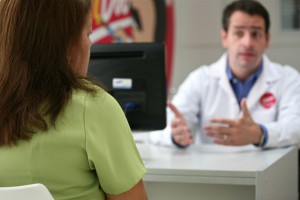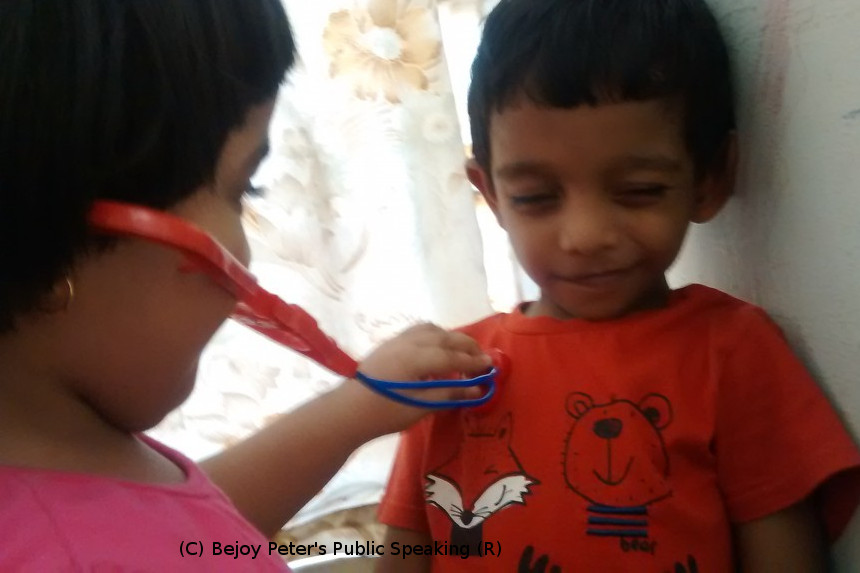A doctor’s profession is a very demanding one. It is therefore difficult to meet each patient with the same care and concern. Yet on the other side the patient expects full and undivided attention. Many doctors weave magic by their pleasant ways and talk. It soothes the heart of the patient and cheers him up. It is therefore important for a doctor to understand how critical it is to know how he or she should communicate.
Smile
A patient usually comes to the doctor in a complicated frame of mind. He has his discomfort to take care of. Then there are anxieties to confront. Above all, the possible causes of the disease, the diagnosis and even prognosis administered by friends and relatives weigh him down. It is in such normal contexts that a patient comes to see a doctor.
If the doctor can gift him or her a radiant smile, half of his disease will disappear. It gives confidence to the patient. It encourages him to open up and speak all that is in his mind.
It might seem easy but actually it is not. The doctor sees hundreds of patients every day. And the time he can allot to each person is very limited. So if the doctor has to gift a smile, these days he has to make a conscious effort to do so. Even though smile is one of the basics of greeting a person, it might be tough to do so in the busy schedules of a doctor’s life.
Yet if he can gift a special smile, its value is more than the medicines that he can prescribe. So let an abundant dosage of Smile be administered when greeting a patient.
Specific Questions
Often patient’s are unable to describe what they are experiencing. It is here that simple prompts from the doctor assumes vital importance.
For example, a patient is complaining of headache. The doctor asks, “Is it a dull pain or a throbbing one or is it kind of a net spread across?” These questions help the patient to speak out correctly what he is experiencing. It clarifies his confused thinking and elicits the right responses.
Often it is a good idea to ask sure-shot `No” answer questions to get the right answer from the patient. For example, a patient comes to the doctor with leg pain. He points to the portion around the ankle. The doctor asks, “So the pain is also experienced in the toes?” The patient says, “No.” Again the doctor says, “You have the pain in the calf and perhaps the knee?” Again, the answer is “No.” This helps to confirm what the patient has initially said. And it helps in quick and accurate diagnosis.
Often patients tend not to disclose some of their past medical history. Reasons can be many. They might consider it insignificant. Or it might have been some twenty years ago they had a bout of chicken pox. So they might think what bearing it might have on the present complaint since it happened long time ago. Or at times the patient might feel that the doctor might become angry because of resorting to another medical stream like Ayurveda or Homeopathy. Sometimes the patient needs time to trust the new doctor.
In all these cases a few intelligent questions from the doctor can put the patient at ease. It can also enable the patient to reveal needed information which can help the diagnosis. In many cases patients have been found to carry on with medicines that a doctor prescribed long after it should have been stopped. This they do trusting in their own faulty common sense. It is important to bring out such misuse of medicines through intelligent questions.
Giving Instructions
One of the challenges that experts face in all professions is to pass on instructions in a very simple manner. It is here that the basics need to be revisited again. To a doctor, what he explains is something he routinely does. Therefore there is likelihood of missing out some simple but vital instruction.
For example, when a child is having high fever, the doctor advises to give sponge bath. Usually doctors suggest not to do it in the area of the chest. But it is likely (perhaps one in a thousand cases) that the doctor forgets to mention the exception. Other examples can include forgetting to communicate that a particular medicine should be discontinued when another one has been started. Or not mentioning that a particular tablet has to be taken half an hour before food and so on. These are simple omissions but there can be serious consequences with major omissions.
The point that has to be made is this: Patients drink in every word that a doctor tells them. Some of them, especially from poor backgrounds may not have the initiative or skill to ask the doctor for more information even when they feel that they need to get some clarification. Often the patient also gets confused by poor listening on the part of his bystanders when the doctor communicates. These bystanders might communicate to him what the doctor said in a different way.
To avoid such communication mishaps, some tips that can be followed are these. One, explain with patience. Two, go step by step. Three, check for understanding by asking the patient questions along the way. Four, ask for feedback. That is make the patient tell what he has understood. Then confirm with bystanders that they have got it right. Thus the doctor can ensure that the communication aspect has been foolproof.
It is also good to tell the patient and the bystanders what exactly needs to be done in case of an emergency situation if it arises. First of all, tell them what possibilities are there for the likelihood of an emergency. Secondly, tell them what to do as first aid. Thirdly, give them the needed contact information. Finally, whenever possible, reassure them that they can call you anytime (or specify the time) if there is any doubt or need.
Another simple but important thing is to instruct the patient about the buying of medicines. Usually those in the medical stores will try to substitute medicines telling the patient that it is one and the same. This creates great confusion. If the doctor can tell in advance whether medicines can be substituted or not, and if so which ones, then it save the patient from some mind-troubling situations.
These steps can build a good communication bridge between the doctor and patient.
Explaining the Situation

A simple term like “Occlusion” for the dentist might sound like a huge dictionary to an uninformed patient. It is here that the doctor needs to translate the medical terminology to a layman’s understanding. As soon as the doctor explains that it means how the teeth fit together, the patient relaxes. For otherwise the sound sense of “Occlusion” is frightening indeed.
Some doctors care enough to explain what is happening. They may display the patients X-ray or CT or MRI scan and show patients their abnormal findings on the images. All this is very comforting to the patient. It puts a lot of confidence in him. At the same time it helps the patient to have greater confidence in the doctor too.
Such knowledge gained from the doctor makes a patient feel that he is in control of the situation. He does not feel helpless. When his relatives and well-wishers come to visit him, he too finds genuine happiness in explaining to them what it is all about. He becomes an expert in no time. Even though the doctor need not educate a patient about all that he is going through some simple explanations can put his mind at ease.
For example, when a doctor shows a diagram of a blood vessel having a block, he is enabling the patient to visualize a “big thing.” The doctor then shows a picture of a small minute wire being inserted through the block and a balloon when inflated opens up the blocked vessel. For preventing further relapse, a stent (a minute pipe) is placed at the site of the block. When the patient sees this he understands the process. His mind feels a lot more at ease having understood what it is all about. This understanding is vital to the healing process. And doctors can provide that with a little bit of imagination and conversation ability.
Of course, the trickiest and perhaps the difficult part comes when explaining grave situations. It is not all easy to break the news. Always it is best to pepper the talk with “hope for the best” statements before the actual situation is described. Naturally the patient will be in all kinds of fear and confusion. And the way a doctor can handle this situation through confidence-building talk can still put some sunshine on what otherwise is a gloomy day.
Jesus and Healing
Jesus healed many during his earthly ministry of 3 1/2 years. He not only healed people with physical illnesses but also the demon possessed. Let us look at how he as the Great Physician communicated during his healing ministry.
Questions First
Often Jesus used to ask those whom he was about to heal: “What do you want me to do for you?” This question acquires importance because not many people really want to be healed. They just talk about getting healed. It is a kind of wishful thinking. But this question of Jesus provokes the patient to really affirm what he needed. And usually Jesus healed when a person gave a reply like, “I want to see (a blind man’s response).”
Forgiveness as a Greater Need
At other times he told a person, “Son, your sins are forgiven,” before he imparted physical healing to him. This kind of communication tells us about the great insight of wisdom and knowledge that Jesus had about a person. Such statements addressed the need of the person to be healed on a deeper level than just the physical healing. In fact, such loving words spoken with authority made a person whole on the inside. And then the physical healing followed.
Divine Possibilities
Finally, Jesus also commanded some persons who were healed like this: “Get up, take your mat and go home.” To a person who was bed-ridden for many years, the possibility of walking is always a distant dream. But such statements were given to make the patient see divine possibilities in life. Even though healing was given, the healed one should act accordingly and move forward in life.
Motivation at times included a warning. To some whom he healed Jesus issued stern warnings not to follow previous sinful lifestyles or else, “Something worse may happen to you.”
“. . . and by his wounds we are healed” — Isaiah 53:5b
A Short Meditation on the Precious Blood of Jesus
—
“An anxious heart weighs a man down, but a kind word cheers him up (Proverbs 12:25).”



